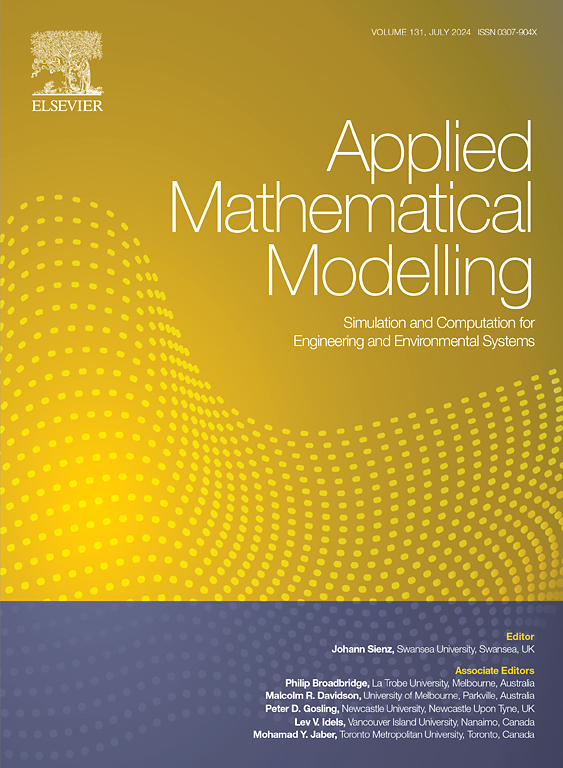A novel temporal finite element method to solve static viscoelastic problems
IF 4.4
2区 工程技术
Q1 ENGINEERING, MULTIDISCIPLINARY
引用次数: 0
Abstract
A novel temporal finite element method is presented to solve static viscoelastic problems, which is more flexible and appropriate to describe temporal variation of displacement than conventional finite difference or numerical integral methods. By using virtual work principle, a spatial finite element based governing equation is derived in terms of displacement and its derivatives. Then two temporal finite element models are developed using Gurtin variational principle and weighted residual technique. A kind of hybrid shape functions with polynomial and trigonometric basis is stressed to give more flexible descriptions of time varying variables. A criterion of stability analysis is derived, which can numerically be conducted when the constitution of shape functions and step size are prescribed. A recursive algorithm toward end is developed by which the temporal FE analysis can be conducted via a matrix power product with the initial condition, instead of step marching. The proposed approach is available for the viscoelastic model described by linear differential equations with order h ≤ 2, and can conveniently be combined with well-developed numerical algorithms to tackle with boundary value problems, such as FEM, SBFEM etc. Various numerical examples, including those with static/harmonic loads, creep, stress singularity and heterogeneous structures, etc. are provided to illustrate the efficiency of the proposed approaches, and impacts of the temporal FE model, constitution of shape functions, and step size, etc. are taken into account. Satisfactory results are achieved in comparison with analytical or ABAQUS-based solutions.
解决静态粘弹性问题的新型时间有限元方法
本文提出了一种解决静态粘弹性问题的新型时空有限元方法,与传统的有限差分或数值积分方法相比,该方法更灵活,更适合描述位移的时空变化。利用虚功原理,以位移及其导数推导出基于空间有限元的控制方程。然后利用 Gurtin 变分原理和加权残差技术建立了两个时间有限元模型。强调了一种以多项式和三角函数为基础的混合形状函数,以便更灵活地描述时变变量。推导出了稳定性分析标准,在规定了形状函数的构成和步长时,可以进行数值分析。最后还开发了一种递归算法,可以通过与初始条件的矩阵幂乘积进行时间 FE 分析,而不是步进。所提出的方法适用于由阶数 h ≤ 2 的线性微分方程描述的粘弹性模型,并可方便地与发达的数值算法(如 FEM、SBFEM 等)相结合,以解决边界值问题。为说明所提方法的效率,提供了各种数值实例,包括静态/谐波载荷、蠕变、应力奇异性和异质结构等,并考虑了时间 FE 模型、形状函数的构成和步长等因素的影响。与分析或基于 ABAQUS 的解决方案相比,结果令人满意。
本文章由计算机程序翻译,如有差异,请以英文原文为准。
求助全文
约1分钟内获得全文
求助全文
来源期刊

Applied Mathematical Modelling
数学-工程:综合
CiteScore
9.80
自引率
8.00%
发文量
508
审稿时长
43 days
期刊介绍:
Applied Mathematical Modelling focuses on research related to the mathematical modelling of engineering and environmental processes, manufacturing, and industrial systems. A significant emerging area of research activity involves multiphysics processes, and contributions in this area are particularly encouraged.
This influential publication covers a wide spectrum of subjects including heat transfer, fluid mechanics, CFD, and transport phenomena; solid mechanics and mechanics of metals; electromagnets and MHD; reliability modelling and system optimization; finite volume, finite element, and boundary element procedures; modelling of inventory, industrial, manufacturing and logistics systems for viable decision making; civil engineering systems and structures; mineral and energy resources; relevant software engineering issues associated with CAD and CAE; and materials and metallurgical engineering.
Applied Mathematical Modelling is primarily interested in papers developing increased insights into real-world problems through novel mathematical modelling, novel applications or a combination of these. Papers employing existing numerical techniques must demonstrate sufficient novelty in the solution of practical problems. Papers on fuzzy logic in decision-making or purely financial mathematics are normally not considered. Research on fractional differential equations, bifurcation, and numerical methods needs to include practical examples. Population dynamics must solve realistic scenarios. Papers in the area of logistics and business modelling should demonstrate meaningful managerial insight. Submissions with no real-world application will not be considered.
 求助内容:
求助内容: 应助结果提醒方式:
应助结果提醒方式:


